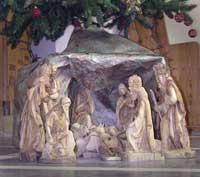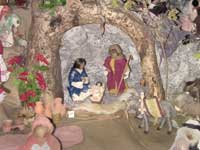The Nativity in 3D: The Crèche helps tell the Christmas story

by Jim Chliboyko
One wouldn’t think a nativity scene—the traditional depiction of the evening of Christ’s birth—would provide too much mileage for comedy. But that didn’t stop Mr. Bean. There’s a famously cheeky (and slightly naughty) bit during Merry Christmas Mr. Bean, in which the man-child decides to play with a nativity display at Harrod’s (department store), killing time while shopping, eventually introducing the infant Jesus to a helicopter, a tank, a T. Rex, and Doctor Who’s old enemy, the Dalek. Mr. Bean has his oblivious fun with it until security chases him away.
The bit works (or doesn’t, depending on your taste) because of the universality of the nativity scene, or crèche; everybody knows what the nativity scene is, just as they know there were no helicopters in Bethlehem all those years ago.
But the Nativity scene isn’t just something that decorates department stores or fills up space or appears in churches during the Christmas season; it’s an art form hundreds of years old. And for some, it is a very important art form.
“The role of Christian art is to teach what Scripture says. It’s a teaching tool” says Rev. Ted Giese, associate pastor at Mount Olive Lutheran Church in Regina. With an undergraduate degree in fine art, he has written two theses on art and the church. “The best Christian art does this in a way that doesn’t confuse but enlightens.”
The role of Christian art is to teach what Scripture says.
And, using that same thinking, the nativity scene tells the story of Christmas and Epiphany focusing on the humble place where God became man.
The Latin word ‘cripia,’ means ‘manger.’ From cripia descend the words crèche and crib, and other words synonymous with the nativity scene.
According to an organization devoted to the crèche, “the earliest representation of the Nativity can be seen in a fresco found in the catacombs of St. Priscilla (in Rome), 2nd century AD, portraying the Mother and Child, the Three Wise Men and Saint Joseph or perhaps the prophet Isaiah, and above a star with eight points.”
Evidently, it wasn’t until the 13th century the idea of the Nativity Scene specifically captured people’s imaginations. Certainly, the mother-and-child portraits were a common theme, but for an actual depiction of the birth of Christ, St. Francis of Assisi often receives credit for pioneering the art form. Specifically, St. Francis began with what’s known today as a living nativity scene, the first one of which he presented in 1223 in Greccio, Italy, a town in the middle of the country (and a place which today has Bethlehem as a sister city), a mere three years before his death.
According to The Life of Saint Francis, by St. Bonaventure, “in order to excite the inhabitants of Grecio (sic) to commemorate the nativity of the Infant Jesus with great devotion, [St. Francis] determined to keep it with all possible solemnity; and lest he should be accused of lightness or novelty, he asked and obtained the permission of the sovereign Pontiff. Then he prepared a manger, and brought hay, and an ox and an ass to the place appointed. The brethren were summoned, the people ran together, the forest resounded with their voices, and that venerable night was made glorious by many and brilliant lights and sonorous psalms of praise.
The man of God [St. Francis] stood before the manger, full of devotion and piety, bathed in tears and radiant with joy; the Holy Gospel was chanted by Francis, Levite of Christ. Then he preached to the people around the nativity of the poor King; and being unable to utter His name for the tenderness of His love, He called Him the Babe of Bethlehem.”
The popularity of the scenes spread outward from Greccio, but carved or sculpted figures eventually replaced (though not totally) the humans and animals. And the art form has changed dramatically over the years in other ways.

In the World Council of Churches chapel (Geneva, Switzerland)
An organization devoted to the art of the crèche, the US-based Friends of the Creche, recently held its annual meeting in Toronto, the first time Canada has hosted. It’s a fairly new organization which established itself in the last decade.
According to its literature, “The American organization is part of a worldwide organization started in Europe in the early 20th century as people became aware of collections of crèche figures created by some of Europe’s finest artists being broken up and sold in the antique market, while others were simply left to deteriorate.”
“Actually, I think the inspiration came from several European societies, some of which have been flourishing for hundreds of years,” said Mike Whelan, president of Friends of the Creche. “I like to say that there’s fifteen Old World societies and three New World ones. The European focus is more on people who build them and create them; the North American group is more for the collector-types.” The group’s start was low-key.
“We had a newsletter before we had a group,” said Whelan. “Rita (Bocher) in Philadelphia saw a need for a newsletter. It sounds hokey, but we actually met in Bethlehem, Pennsylvania, in 1999…and there’s a Moravian church near there with an exhibit. Bethlehem seemed like a perfect place.”
Whelan’s own fascination with the nativity began in his youth. He had a handy uncle who did some carpentry on the side, and who made a stable for him. Whelan, at the age of seven, bought some figures for his own nativity scene at a local dime store.
“For me, there’s always been an interest in it; I’m not sure why. Six or seven must have been a formative age. The same thing seems to run through our membership.”
David Guy is a member of Red Deer’s Mt. Calvary Lutheran Church, and is also deeply interested in the crèche. He, too, attended this year’s convention in Toronto.
“I don’t know how many sets I have anymore. Maybe 350 to 400,” says Guy. “I set them up in the church, then open it to the public. There are scenes from different materials, scenes from different countries. I actually get most of mine from eBay, but not necessarily from the Canadian or American eBay sites.”
“I don’t have enough room to put them all out anymore, so I try to rotate some stuff, and try to keep it as varied as I can.”
Guy became involved with collecting nativity art at a later age than Whelan, but it became an important part of his life. “I’ve always been interested, but the collecting started 10 years ago. I got into a very bad depression. I couldn’t think, couldn’t concentrate. But working with the nativity sets gave me something to concentrate on. I think God gave me something to do. It was something I could work with.”

In the village church of Leukerbad, Switzerland
Today’s crèche can take many forms depending on the artist’s whimsy, craftiness, skill or the materials available.
“One I have from South America is basically made out of recycled car parts,” says Whelan. “The hay in the manger is spark plug wires, and the infant Jesus is basically part of a spark plug.”
Whelan also talks about nativity scenes made out of everything from recycled aluminum pop cans to a Vietnamese item made from mother-of-pearl.
“One of the very unique ones I have is made of fine sawdust and oxblood,” says Red Deer’s Guy, who compares it to Bakelite. “It’s made in late 1800s inFrance.”
Of course, many of the pieces from poorer countries have a purpose other than celebrating the birth of Jesus. Says Whelan, “The third or fourth dimension of this is that a lot of people support mission projects throughout the world (through the purchase of nativity art).”
“I have one made out of orange peels from Columbia,” reported David Guy. “That one I got from a gentleman I know in Salt Lake City. His family buys directly from the artist and sends the money back to the artist.
While an 800-year time span can lead to all sorts of changes in one discipline, Whelan thinks he can sense a recent shift in how people regard the art form.
“I have to say, I think after 9/11 I saw things change a little bit. I think people started to see things differently. If you ever shop for Christmas cards, you may have seen one little section for religious cards (before), but that section is growing a little more.”
Whelan insists his group isn’t at all political. To be sure, some political issues have arisen in the past with nativity scenes, but aside from the occasional act of destruction, mischief or the rare high-profile protest, Whelan downplays anything negative in relation to the scenes.
“Here and there maybe you get some vandalism with public displays,” says Whelan. “A friend tells me people like to steal the infant. For the most part people who come to exhibits are people who… want to come there.”
It’s impossible to say what St. Francis of Assisi had in mind when he arranged his first Nativity scene all those years ago—whether he was trying to create a full-blown tradition or a one-off production. But almost 800 years later, much of the Christian world still devotes time and energy to this category of Christian art.
If St. Bonaventure was correct, and St. Francis’ efforts were merely to generate some excitement about commemorating the birth of Jesus, it seems he just might have—788 Christmases later—been on to something.
——————–
Jim Chliboyko is a freelance writer in Winnipeg.
Photographs by Ian Adnams.





